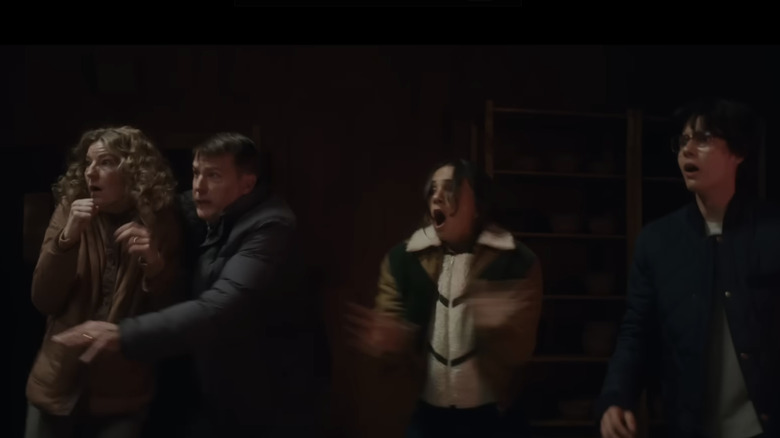In the case of horror films, followers love to determine the place their favourite movies match. Which is why films like “The Black Telephone” and its sequel, this month’s “Black Telephone 2,” can present some participating debate or some irritation, relying in your character and style. That is as a result of the movies do not neatly match right into a pre-fabricated subgenre class; they include parts of the serial killer thriller, the supernatural horror movie, and the slasher, that means they do not neatly match into any of these subgenres. Thus, those that name “Black Telephone 2” a slasher movie by default really feel annoyed by the film, particularly given the truth that the “Nightmare on Elm Road” films, being usually considered a slasher sequence, are a transparent affect on the sequel. Their primary criticism in opposition to “Black Telephone 2” is that, in contrast to the vast majority of different slasher movies, nobody in it dies; all of the murders in it have taken place earlier than the occasions of the movie.
Whereas this distinctive high quality is what helps “Black Telephone 2” really feel impressed for these of us who benefit from the movie, it actually was some extent of competition that arose whereas making the film. Director/co-writer Scott Derrickson and co-writer C. Robert Cargill had been adamant from the beginning that they needed to make a scary film the place there have been no on-screen deaths. But one studio govt had a observe that would’ve led to that idea being modified.
As Jacob Corridor realized throughout a latest chat with Cargill for the /Movie Weekly Podcast, the character who nearly discovered themselves getting offed within the film was Barbara (Maev Beaty), somebody who, in a normal slasher film, would completely be first on the chopping block. Nevertheless, Cargill and Derrickson caught to their weapons, permitting “Black Telephone 2” to proceed to defy expectations.
Cargill and Derrickson had been impressed by a 1980 horror traditional to not kill any characters
The filmmakers’ curiosity in not killing any characters on display throughout “Black Telephone 2” wasn’t an arbitrary alternative. As a substitute, the duo was impressed by 1980’s “The Changeling.” Whereas primarily a ghost story and by no means anticipated to be a horror film with a heavy physique rely, it stays some of the chilling horror movies ever made. As Cargill defined to /Movie, he and Derrickson had been occupied with experimenting with the same tone for “Black Telephone 2”:
“Considered one of me and Scott’s favourite ghost tales of all time is ‘The Changeling,’ and that’s an absolute low physique rely film, but it surely’s terrifying…So we knew we did not need to kill folks to make folks scared. We additionally knew that individuals would assume they had been in peril, so simply by the very facet of getting them there, if we made them attention-grabbing sufficient, if we made them likable sufficient, folks would care about whether or not they lived or died.”
Each Cargill and Derrickson had been conscious that they could not tease the viewers an excessive amount of to the purpose of frustration. Particularly given how “Black Telephone 2” is about up like an “Elm Road”-style slasher, with the Grabber (Ethan Hawke) now being able to assault folks in the actual world from the past. Thus, the filmmakers needed to be picky with their pacing when it comes to which character(s) would get attacked and what number of instances, as Cargill mentioned:
“It did form of hamstring us in that we could not maintain faking the viewers out. We could not maintain placing folks in peril and pulling them out of hazard with no person getting harm. So it did give us a restricted variety of instances we might get away with that form of buildup.”
Having nobody killed throughout ‘Black Telephone 2’ allowed the filmmakers to give attention to the story
Meaning to make a scary film with out kill scenes allowed “Black Telephone 2” to be a meaty movie that did not require a physique rely to remain participating. In actual fact, Cargill and Derrickson found that they had the alternative drawback. As Cargill defined:
“There have been discussions later about killing characters, however we at all times … discovered we had been reducing out character scenes, we had been reducing out deeper pushes into mythology. We simply did not have the area for it, and likewise we had the scares that did not want it. So we had been capable of join with audiences and scare the crap out of them with out having to have a physique rely.”
The bait-and-switch facet of “Black Telephone 2,” which is a movie about an undead serial killer who does not do any killing on-screen, did ultimately chafe through the filmmaking course of, as with that unnamed govt who proposed including the loss of life of Barbara. Her character is a straightforward goal contemplating how closed-minded she is. But Cargill confirmed that no model of the movie’s script included a loss of life scene for any fundamental character:
“There was an ask from an exec sooner or later, it was like, ‘Can we simply no less than kill the b****y Christian character?’, which is the one that everyone’s like, ‘She was the one which was going to die, proper?’ However no, we had by no means killed any of those characters in any of the drafts.”
Because the movie’s field workplace reception proves, this alternative hardly deterred audiences from exhibiting as much as see the Grabber be scary and menacing. Hawke’s efficiency because the character is unsettling sufficient to make him a real risk, that means neither the Grabber nor “Black Telephone 2” requires a physique rely to be efficient.

![This Black Telephone 2 Character May’ve Died Thanks To A Studio Word [Exclusive] This Black Telephone 2 Character May’ve Died Thanks To A Studio Word [Exclusive]](https://www.slashfilm.com/img/gallery/this-black-phone-2-character-couldve-died-thanks-to-a-studio-note-exclusive/l-intro-1761264317.jpg)

